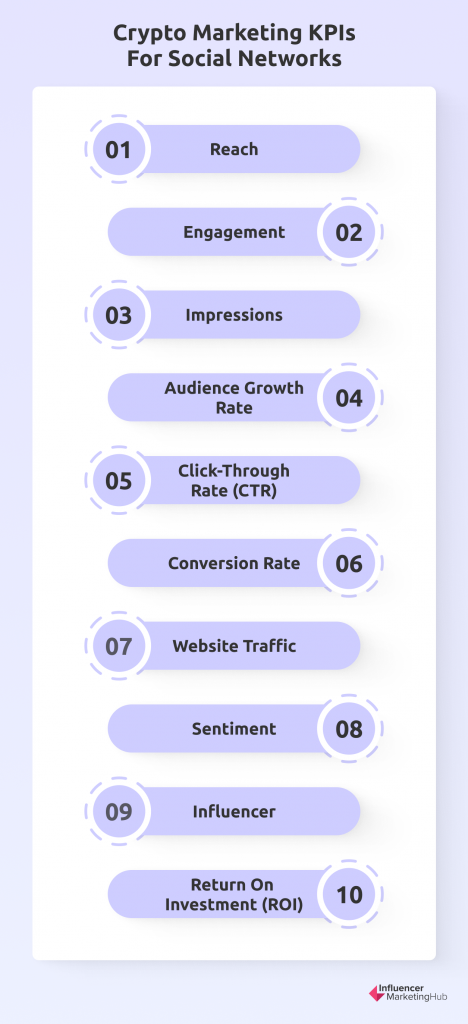The whole crypto ecosystem has grown, thanks in part to social media. Developers, exchanges, and marketers use social media to educate a growing crypto audience. This is essential because, compared to other types of digital currency, the crypto market is newer and more complicated.
There is a correlation between social media engagement and cryptocurrency. Trading websites and crypto analysts provide valuable information on crypto-related current events and articles that demystify the topic. It also sparks constructive debates on the merits of the various coins on the market and increases social media engagement.
A robust social media marketing strategy is essential for a cryptocurrency project to get attention and credibility. While other industries have more flexibility on social networks, cryptocurrency posts need a considerable assessment before posting. Many centralized platforms have imposed restrictions on content meant to promote cryptocurrency.
Monitoring social media activity related to cryptocurrency projects helps evaluate market sentiment. The audience engages with a project's social media presence and acquires assets if they want to contribute. Due to these social media posts, traders and miners may improve their skills. Potential traders also use social media to get relevant direction and resources before dipping their toes in the crypto market. This gives them a head start and creates a space for discussions regarding industry trends and their progress.
Every cryptocurrency project has a set of social media marketing goals. Marketers must track which strategy is effective for the target market. Marketing metrics are used to assess and measure a project's performance. They help figure out how well a cryptocurrency project is being marketed. They also offer a clear picture of what aspects of the marketing plan work effectively and what parts need modifications.
10 Crypto Marketing Metrics to Measure for Social Media Growth:
Crypto Marketing KPIs for Social Networks
A considerable part of the success of your crypto project depends on having a social media marketing plan for growth. The good news is that social media allows for tracking practically any data. But, that's also the worst part of it. The discipline required for success in a crypto project is identifying which Key Performance Indicators (KPIs) are most important.
The core purpose of the project, its scale, and your end goals are just a few of many variables that will influence how many metrics you track. You can focus on the most important indicators and measure performance over time by setting suitable KPIs for your crypto marketing initiatives. Here are the key metrics to monitor.
-
Reach
It's unlikely that every one of your followers will see your posts. It's possible for people who aren't your followers to view your content. Reach is the total number of people, followers or not, who saw your crypto social update.
Look at the ratio of followers to non-followers in your reach. Your post is either being shared or doing well in the algorithms if it is viewed by a significant number of people who are not followers. It can also be a combination of the two. It's a good idea to keep track of your overall reach and the reach of any specific post.
Reach can be linked to brand awareness too. Brand awareness can help you establish your reputation as an authority in the cryptocurrency market. It also helps in attracting new customers.
-
Impressions
The impression is calculated by how many times users view your content. Even when someone shares your post, the user may not engage with it. The content itself may bounce more than once. Because a user may view your post multiple times, impressions can be higher than reach.
When the ratio of impressions to reach is high, it means that people see your content repeatedly. In this instance, it's imperative to study the content and determine its appeal. You may build on it and expand the subject to include more information.
-
Engagement
Engagement is the total number of likes, comments or responses, shares, and reactions associated with a post. A percentage of your audience is used to determine the engagement rate of your content.
Identifying the kind of crypto-related content the market is interested in can be tricky. However, you can assess which material appeals to your audience based on the engagement rate. The foundation of an effective social media crypto marketing strategy is engagement.
Your key goal is to maintain readers’ attention to your posts. Say you have fewer followers, but they all engage with your content. This is a positive indicator that your social media efforts are paying off.
You may track your engagement rate over a certain period. To calculate:
Monitor your progress by measuring the engagement rate for each period.
-
Audience Growth Rate
Audience growth rate measures how many new social media followers you’ve acquired over a specific timeframe. Keeping tabs on follower count is pretty straightforward. You can directly access the numbers from your profile. Keeping track of audience growth can help you gauge your following's growth. It's not how many followers you have but how fast they grow.
The audience growth rate in the cryptocurrency market is intrinsically tied to community building. When there's audience growth, some followers will become community members. If your social network account is new, getting 10 to 100 followers monthly is a great way to be noticed and provides a rapid boost. But if your crypto social account is popular and has many followers, you need more followers to keep the momentum going.
Calculating how fast your audience is growing takes a bit more work. You must first set a reporting window which can be weekly, monthly, or quarterly. Identify your new followers during that period. Divide that number by your total audience. The result is your audience growth rate. You can now compare your followers' growth rates over time and see where they improved.
-
Click-through rate (CTR)
Click-through rate is the frequency with which viewers click a link in your post to access additional content. A blog entry, a video, a story, or your cryptocurrency website could all qualify as such.
You can market your crypto project with ad words. Posting such ads or CTA links on social networks can help boost clicks. It's essential to track how many people click on them, as it shows how many people read your post and searched for further information. It also helps you determine how many people are interested in your cryptocurrency project and services.
You may measure your click-through rate for a specific timeframe. To calculate:
-
Conversion rate
Conversion rate is the total number of users that click a link in your post and do the intended action. Remember that clicks and conversions are not comparable. A click doesn't always follow a conversion. A robust social marketing strategy can increase the conversion rate of your cryptocurrency project.
Conversion actions are the ultimate step you want people to do on your channel. These actions include downloading, registering, subscribing, installing, buying, and more. This is a critical social marketing metric since it highlights your social content's value to feed your funnel.
To calculate the conversion rate, you need to set a specific period:
-
Website traffic
For cryptocurrency marketers, website traffic is a critical metric. Boosting web traffic can help raise brand awareness and recognition. It can also generate more revenue.
Tracking web traffic assists you in better understanding what content your audience wants and what you should work on next. Analyze the website traffic for the selected time frame to see which social media content produces the most traffic. It will help you plan comparable content to drive traffic in the future. The more you analyze the traffic and the audience, the easier it is to produce high-quality crypto-related content.
Using tools like Google Analytics, you can quickly determine the number of repeat visits to your website and new visitors driven by your social channels. There are also other analytic tools available that can help you increase traffic to your website.

Source: reliablesoft.net
-
Sentiment
Social sentiment analyzes the emotions and thoughts behind a social media conversation. It's the metric that reveals if the volume of mentions or the discussion around your brand or project is good, bad, or neutral. Sentiment is especially vital if you're running a sizable cryptocurrency marketing campaign. It's also a parameter that can help you provide outstanding customer service.
The volume of mentions is the metric on which your social media analysis will be based. At first sight, a significant number of mentions may suggest that the crypto marketing strategy was a success. After all, your project is being discussed. However, this is not the whole picture. High volumes of negative mentions spell disaster. You need a plan B to save the project's marketing efforts from a social media crisis.
Analytics tools that can scan, analyze, and categorize language and context are necessary to measure social sentiment.
-
Influencer
Influencers are viewed ambivalently by social media marketers. Nonetheless, today’s landscape of influencer marketing is rapidly evolving. Crypto influencer marketing enables direct communication between the influencer and the marketer. As such, building a genuine, reliable alliance is feasible. Also, there's nothing to worry about as long as you know each other's roles and boundaries.
Influencers may impact your sales. Choosing the right influencer to collaborate with is the first step in a savvy social media strategy. You can find the right person for the job using carefully selected social media metrics. Influencer marketing is one of the most effective social media efforts, primarily if your KPI is engagement.
One of the goals of influencer marketing is to boost brand recognition among potential customers and influencers. This metric can be measured effectively by comparing the before-and-after data on Google Trends. When you run an influencer campaign, if people search for your crypto website or project more often, this indicates that brand recognition has increased.
-
Return on Investment (ROI)
Say you've created a comprehensive cryptocurrency marketing strategy for social media and spent time and resources to ensure the campaign's success. Even if you've kept track of every metric, getting a return on investment is the prime objective of all your efforts.
Depending on your cryptocurrency niche and social media activities, ROI will vary. For instance, the ROI for running a DeFi project and a Metaverse campaign will differ. The platforms you're using also affect the end goal. Your ROI on Facebook can be diverse from that of Instagram or Twitter. As such, it's vital to establish ROI goals for each platform.
To calculate ROI:
Your social media crypto marketing metrics should be summarized in an analytical report. And every time you monitor your KPIs, you may compare the reports to determine how well your crypto project performs.
The Correlation Between Cryptocurrency and Social Media
The market cap of cryptocurrency is $1.76 trillion. This makes the cryptocurrency industry the world's eighth-largest economy. More companies will embrace the crypto market, and competition will be fierce. This also indicates that cryptocurrency will see unprecedented growth on social media.

Source: unsplash.com
Campaigns for cryptocurrencies rely heavily on the popularity of social media groups. To spread awareness about a project, crypto marketing agencies should leverage various social media networks such as Reddit, Twitter, YouTube, Facebook, Medium, Discord, and Steemit. Focusing on crypto-specific platforms like Reddit and Steemit will improve your cryptocurrency and blockchain marketing approach. This provides you a competitive edge when pitching and advertising your blockchain solutions, since you're communicating with an informed audience.
As long as crypto-related news, content, and development dominate social feeds, the direction and future of crypto-social relations remain promising. And for better or worse, social media impacts cryptocurrency price movements.
Using a Crypto Marketing Agency
Hiring experts to help you with any marketing endeavor, especially complex subjects like cryptocurrency, is a sound investment. Several crypto agencies are available on the market now; all you need to do is choose one that understands your crypto project and can meet your needs. These services can help you manage your social media networks and provide detailed reports at regular intervals.
Frequently Asked Questions
What is cryptocurrency marketing?
Cryptocurrency marketing refers to the promotion and sale of crypto-related products or services. It covers any activity related to building brand awareness, attracting new consumers, retaining repeat business, and increasing sales of cryptocurrencies.
What is the importance of tracking social media metrics?
Social media metrics show if your marketing strategy is working or not. They highlight the areas for improvement. They also show you how much time and resources you put in and how much you get back in return. You cannot make informed business decisions on your marketing campaigns without tracking your key metrics.



